Management Accounting Report: Techniques and Analysis for Clarasys Ltd
VerifiedAdded on 2020/11/23
|20
|6322
|492
Report
AI Summary
This report delves into the intricacies of management accounting, exploring various systems and reporting methods. It begins with an introduction to management accounting, contrasting it with financial accounting and highlighting its essential requirements. The report then examines different types of management accounting systems, including cost accounting, inventory management, job costing, and price optimization systems. The analysis extends to different reporting methods, such as ratio analysis, budget reports, and job cost reports. The report further discusses the benefits of these systems and their applications within an organizational context, followed by an integration of management accounting systems and reporting within organizational processes. The core of the report focuses on cost analysis techniques, specifically absorption and marginal costing, preparing income statements using these methods, and applying a range of management accounting techniques to produce appropriate financial accounting documents. The report also evaluates the advantages and disadvantages of planning tools used for budgetary control, analyzing their use in budget preparation and forecasting. Finally, it examines how organizations adapt management accounting systems to respond to financial problems, using various planning tools to resolve these issues.
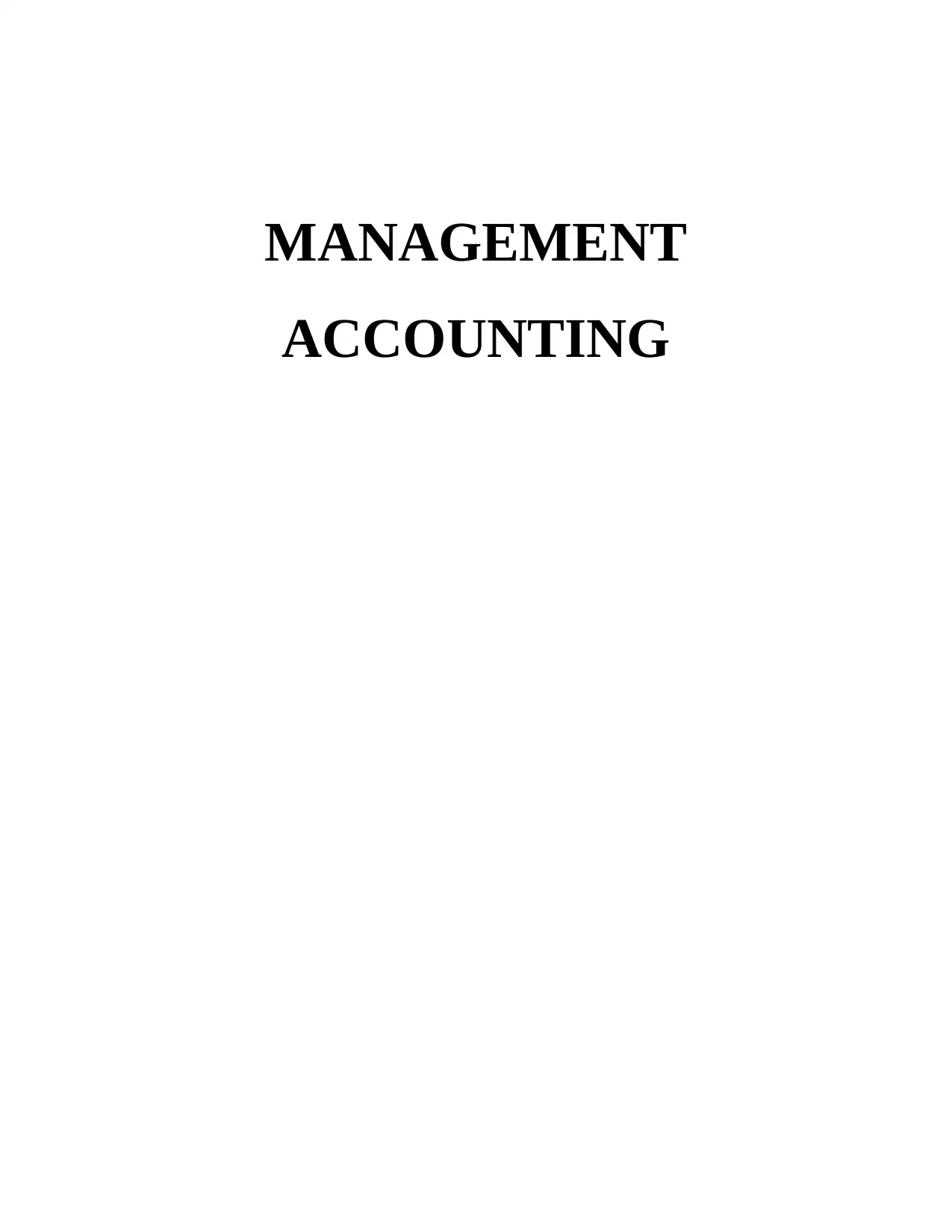
MANAGEMENT
ACCOUNTING
ACCOUNTING
Paraphrase This Document
Need a fresh take? Get an instant paraphrase of this document with our AI Paraphraser
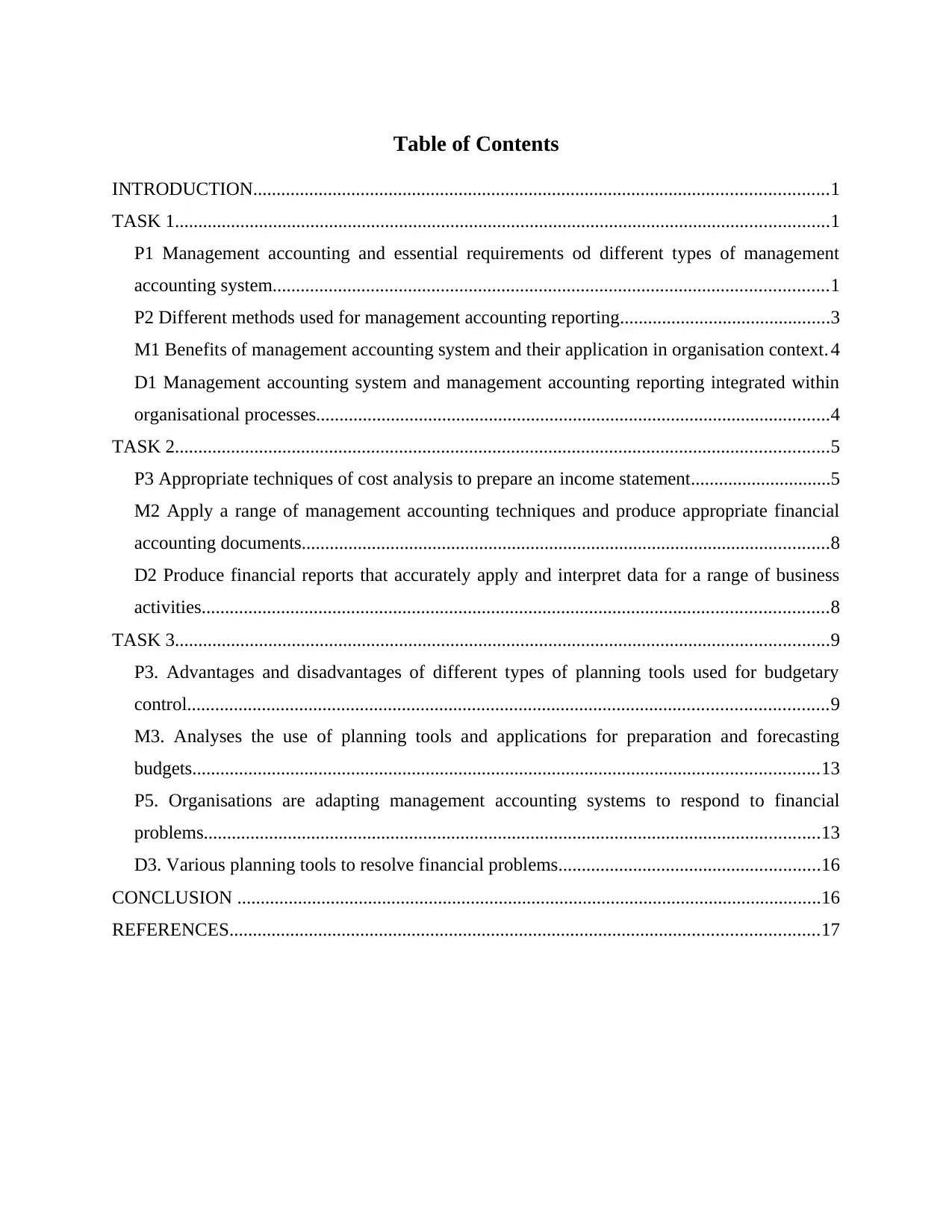
Table of Contents
INTRODUCTION...........................................................................................................................1
TASK 1............................................................................................................................................1
P1 Management accounting and essential requirements od different types of management
accounting system.......................................................................................................................1
P2 Different methods used for management accounting reporting.............................................3
M1 Benefits of management accounting system and their application in organisation context. 4
D1 Management accounting system and management accounting reporting integrated within
organisational processes..............................................................................................................4
TASK 2............................................................................................................................................5
P3 Appropriate techniques of cost analysis to prepare an income statement..............................5
M2 Apply a range of management accounting techniques and produce appropriate financial
accounting documents.................................................................................................................8
D2 Produce financial reports that accurately apply and interpret data for a range of business
activities......................................................................................................................................8
TASK 3............................................................................................................................................9
P3. Advantages and disadvantages of different types of planning tools used for budgetary
control.........................................................................................................................................9
M3. Analyses the use of planning tools and applications for preparation and forecasting
budgets......................................................................................................................................13
P5. Organisations are adapting management accounting systems to respond to financial
problems....................................................................................................................................13
D3. Various planning tools to resolve financial problems........................................................16
CONCLUSION .............................................................................................................................16
REFERENCES..............................................................................................................................17
INTRODUCTION...........................................................................................................................1
TASK 1............................................................................................................................................1
P1 Management accounting and essential requirements od different types of management
accounting system.......................................................................................................................1
P2 Different methods used for management accounting reporting.............................................3
M1 Benefits of management accounting system and their application in organisation context. 4
D1 Management accounting system and management accounting reporting integrated within
organisational processes..............................................................................................................4
TASK 2............................................................................................................................................5
P3 Appropriate techniques of cost analysis to prepare an income statement..............................5
M2 Apply a range of management accounting techniques and produce appropriate financial
accounting documents.................................................................................................................8
D2 Produce financial reports that accurately apply and interpret data for a range of business
activities......................................................................................................................................8
TASK 3............................................................................................................................................9
P3. Advantages and disadvantages of different types of planning tools used for budgetary
control.........................................................................................................................................9
M3. Analyses the use of planning tools and applications for preparation and forecasting
budgets......................................................................................................................................13
P5. Organisations are adapting management accounting systems to respond to financial
problems....................................................................................................................................13
D3. Various planning tools to resolve financial problems........................................................16
CONCLUSION .............................................................................................................................16
REFERENCES..............................................................................................................................17
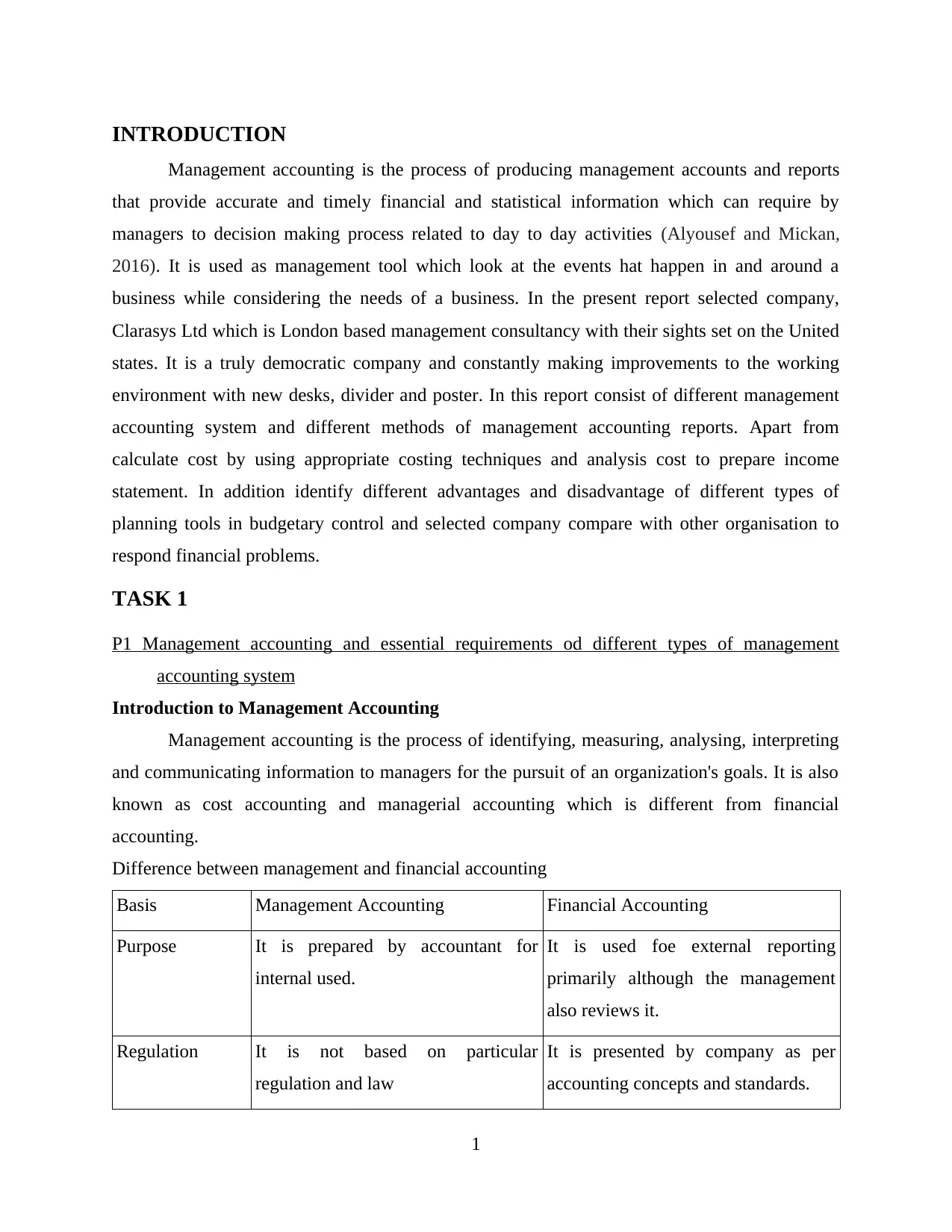
INTRODUCTION
Management accounting is the process of producing management accounts and reports
that provide accurate and timely financial and statistical information which can require by
managers to decision making process related to day to day activities (Alyousef and Mickan,
2016). It is used as management tool which look at the events hat happen in and around a
business while considering the needs of a business. In the present report selected company,
Clarasys Ltd which is London based management consultancy with their sights set on the United
states. It is a truly democratic company and constantly making improvements to the working
environment with new desks, divider and poster. In this report consist of different management
accounting system and different methods of management accounting reports. Apart from
calculate cost by using appropriate costing techniques and analysis cost to prepare income
statement. In addition identify different advantages and disadvantage of different types of
planning tools in budgetary control and selected company compare with other organisation to
respond financial problems.
TASK 1
P1 Management accounting and essential requirements od different types of management
accounting system
Introduction to Management Accounting
Management accounting is the process of identifying, measuring, analysing, interpreting
and communicating information to managers for the pursuit of an organization's goals. It is also
known as cost accounting and managerial accounting which is different from financial
accounting.
Difference between management and financial accounting
Basis Management Accounting Financial Accounting
Purpose It is prepared by accountant for
internal used.
It is used foe external reporting
primarily although the management
also reviews it.
Regulation It is not based on particular
regulation and law
It is presented by company as per
accounting concepts and standards.
1
Management accounting is the process of producing management accounts and reports
that provide accurate and timely financial and statistical information which can require by
managers to decision making process related to day to day activities (Alyousef and Mickan,
2016). It is used as management tool which look at the events hat happen in and around a
business while considering the needs of a business. In the present report selected company,
Clarasys Ltd which is London based management consultancy with their sights set on the United
states. It is a truly democratic company and constantly making improvements to the working
environment with new desks, divider and poster. In this report consist of different management
accounting system and different methods of management accounting reports. Apart from
calculate cost by using appropriate costing techniques and analysis cost to prepare income
statement. In addition identify different advantages and disadvantage of different types of
planning tools in budgetary control and selected company compare with other organisation to
respond financial problems.
TASK 1
P1 Management accounting and essential requirements od different types of management
accounting system
Introduction to Management Accounting
Management accounting is the process of identifying, measuring, analysing, interpreting
and communicating information to managers for the pursuit of an organization's goals. It is also
known as cost accounting and managerial accounting which is different from financial
accounting.
Difference between management and financial accounting
Basis Management Accounting Financial Accounting
Purpose It is prepared by accountant for
internal used.
It is used foe external reporting
primarily although the management
also reviews it.
Regulation It is not based on particular
regulation and law
It is presented by company as per
accounting concepts and standards.
1
⊘ This is a preview!⊘
Do you want full access?
Subscribe today to unlock all pages.

Trusted by 1+ million students worldwide
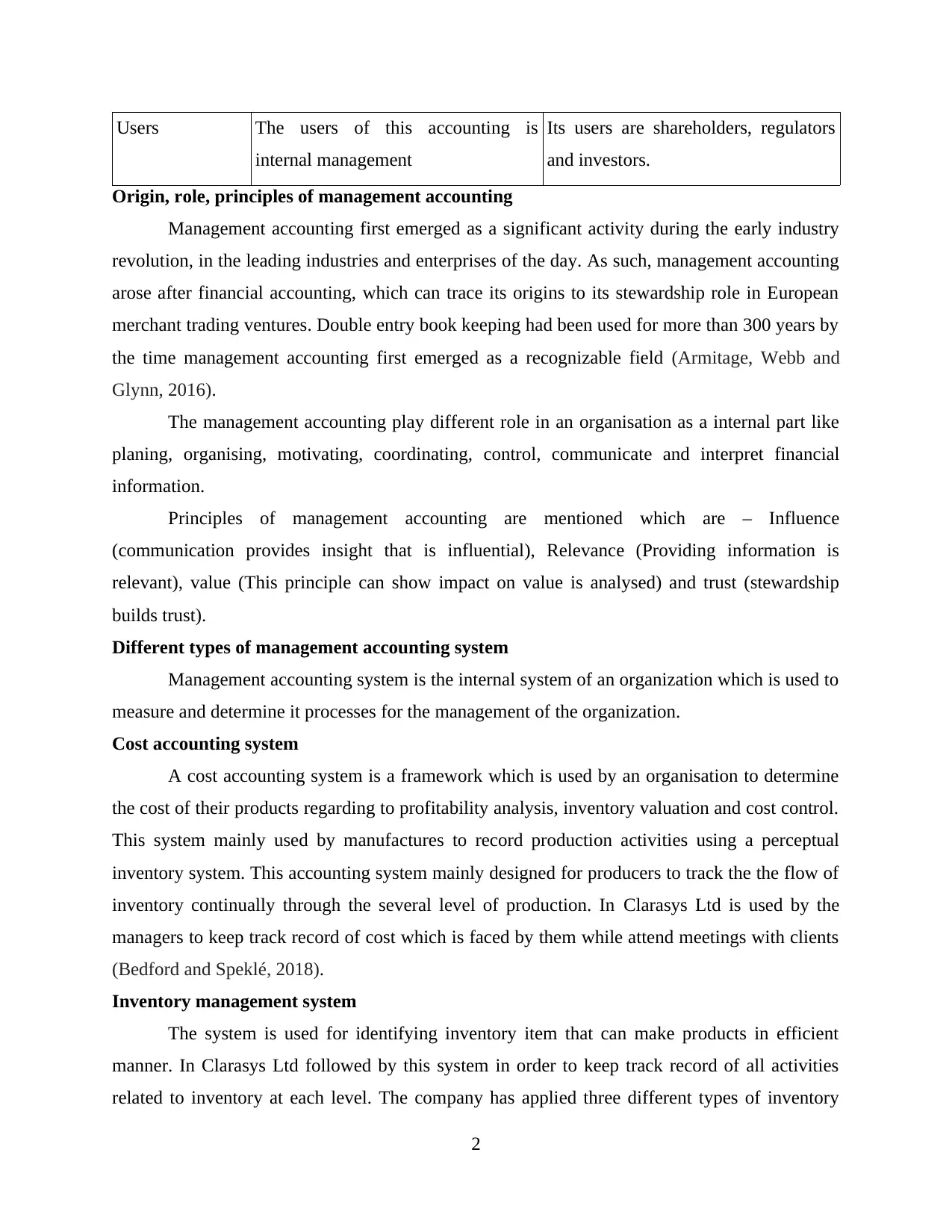
Users The users of this accounting is
internal management
Its users are shareholders, regulators
and investors.
Origin, role, principles of management accounting
Management accounting first emerged as a significant activity during the early industry
revolution, in the leading industries and enterprises of the day. As such, management accounting
arose after financial accounting, which can trace its origins to its stewardship role in European
merchant trading ventures. Double entry book keeping had been used for more than 300 years by
the time management accounting first emerged as a recognizable field (Armitage, Webb and
Glynn, 2016).
The management accounting play different role in an organisation as a internal part like
planing, organising, motivating, coordinating, control, communicate and interpret financial
information.
Principles of management accounting are mentioned which are – Influence
(communication provides insight that is influential), Relevance (Providing information is
relevant), value (This principle can show impact on value is analysed) and trust (stewardship
builds trust).
Different types of management accounting system
Management accounting system is the internal system of an organization which is used to
measure and determine it processes for the management of the organization.
Cost accounting system
A cost accounting system is a framework which is used by an organisation to determine
the cost of their products regarding to profitability analysis, inventory valuation and cost control.
This system mainly used by manufactures to record production activities using a perceptual
inventory system. This accounting system mainly designed for producers to track the the flow of
inventory continually through the several level of production. In Clarasys Ltd is used by the
managers to keep track record of cost which is faced by them while attend meetings with clients
(Bedford and Speklé, 2018).
Inventory management system
The system is used for identifying inventory item that can make products in efficient
manner. In Clarasys Ltd followed by this system in order to keep track record of all activities
related to inventory at each level. The company has applied three different types of inventory
2
internal management
Its users are shareholders, regulators
and investors.
Origin, role, principles of management accounting
Management accounting first emerged as a significant activity during the early industry
revolution, in the leading industries and enterprises of the day. As such, management accounting
arose after financial accounting, which can trace its origins to its stewardship role in European
merchant trading ventures. Double entry book keeping had been used for more than 300 years by
the time management accounting first emerged as a recognizable field (Armitage, Webb and
Glynn, 2016).
The management accounting play different role in an organisation as a internal part like
planing, organising, motivating, coordinating, control, communicate and interpret financial
information.
Principles of management accounting are mentioned which are – Influence
(communication provides insight that is influential), Relevance (Providing information is
relevant), value (This principle can show impact on value is analysed) and trust (stewardship
builds trust).
Different types of management accounting system
Management accounting system is the internal system of an organization which is used to
measure and determine it processes for the management of the organization.
Cost accounting system
A cost accounting system is a framework which is used by an organisation to determine
the cost of their products regarding to profitability analysis, inventory valuation and cost control.
This system mainly used by manufactures to record production activities using a perceptual
inventory system. This accounting system mainly designed for producers to track the the flow of
inventory continually through the several level of production. In Clarasys Ltd is used by the
managers to keep track record of cost which is faced by them while attend meetings with clients
(Bedford and Speklé, 2018).
Inventory management system
The system is used for identifying inventory item that can make products in efficient
manner. In Clarasys Ltd followed by this system in order to keep track record of all activities
related to inventory at each level. The company has applied three different types of inventory
2
Paraphrase This Document
Need a fresh take? Get an instant paraphrase of this document with our AI Paraphraser
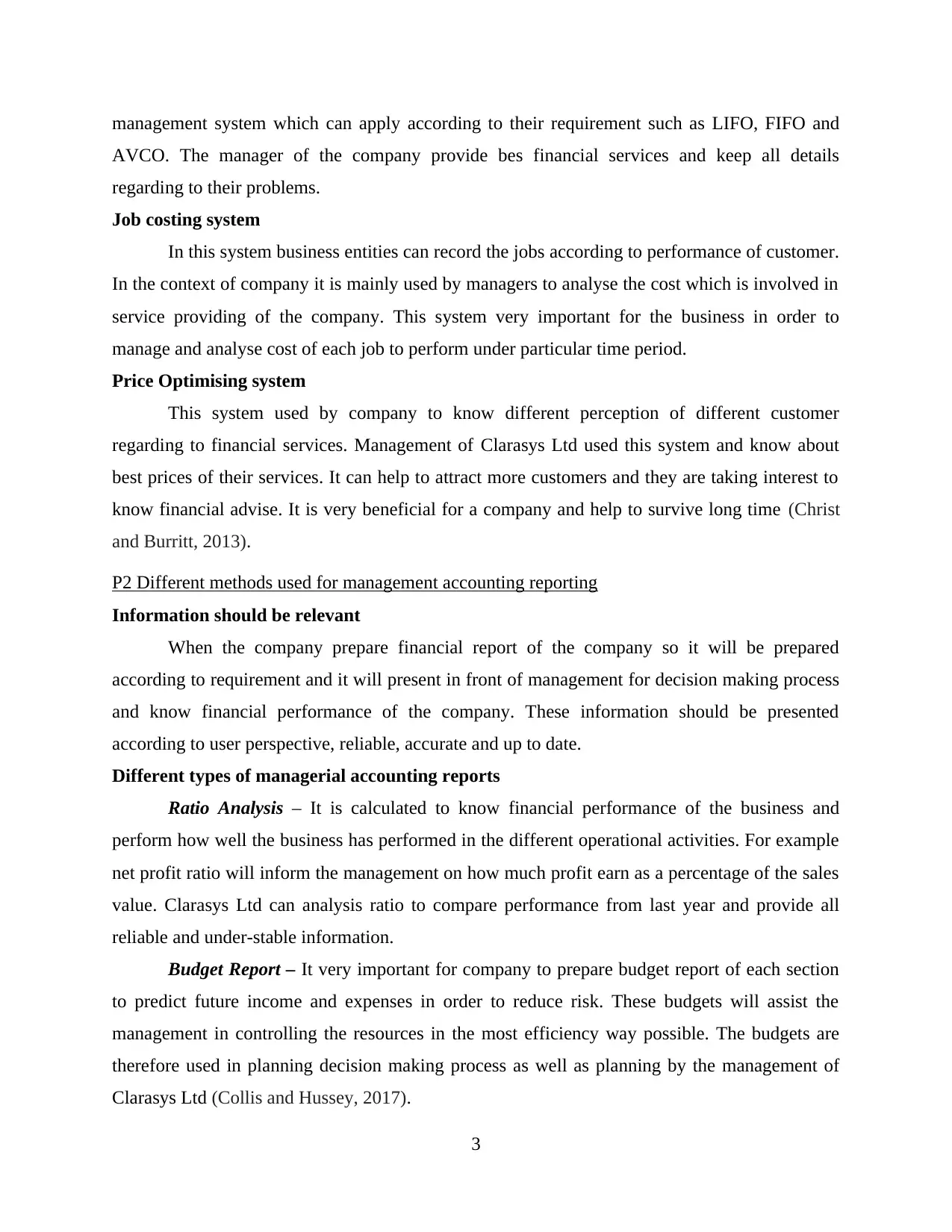
management system which can apply according to their requirement such as LIFO, FIFO and
AVCO. The manager of the company provide bes financial services and keep all details
regarding to their problems.
Job costing system
In this system business entities can record the jobs according to performance of customer.
In the context of company it is mainly used by managers to analyse the cost which is involved in
service providing of the company. This system very important for the business in order to
manage and analyse cost of each job to perform under particular time period.
Price Optimising system
This system used by company to know different perception of different customer
regarding to financial services. Management of Clarasys Ltd used this system and know about
best prices of their services. It can help to attract more customers and they are taking interest to
know financial advise. It is very beneficial for a company and help to survive long time (Christ
and Burritt, 2013).
P2 Different methods used for management accounting reporting
Information should be relevant
When the company prepare financial report of the company so it will be prepared
according to requirement and it will present in front of management for decision making process
and know financial performance of the company. These information should be presented
according to user perspective, reliable, accurate and up to date.
Different types of managerial accounting reports
Ratio Analysis – It is calculated to know financial performance of the business and
perform how well the business has performed in the different operational activities. For example
net profit ratio will inform the management on how much profit earn as a percentage of the sales
value. Clarasys Ltd can analysis ratio to compare performance from last year and provide all
reliable and under-stable information.
Budget Report – It very important for company to prepare budget report of each section
to predict future income and expenses in order to reduce risk. These budgets will assist the
management in controlling the resources in the most efficiency way possible. The budgets are
therefore used in planning decision making process as well as planning by the management of
Clarasys Ltd (Collis and Hussey, 2017).
3
AVCO. The manager of the company provide bes financial services and keep all details
regarding to their problems.
Job costing system
In this system business entities can record the jobs according to performance of customer.
In the context of company it is mainly used by managers to analyse the cost which is involved in
service providing of the company. This system very important for the business in order to
manage and analyse cost of each job to perform under particular time period.
Price Optimising system
This system used by company to know different perception of different customer
regarding to financial services. Management of Clarasys Ltd used this system and know about
best prices of their services. It can help to attract more customers and they are taking interest to
know financial advise. It is very beneficial for a company and help to survive long time (Christ
and Burritt, 2013).
P2 Different methods used for management accounting reporting
Information should be relevant
When the company prepare financial report of the company so it will be prepared
according to requirement and it will present in front of management for decision making process
and know financial performance of the company. These information should be presented
according to user perspective, reliable, accurate and up to date.
Different types of managerial accounting reports
Ratio Analysis – It is calculated to know financial performance of the business and
perform how well the business has performed in the different operational activities. For example
net profit ratio will inform the management on how much profit earn as a percentage of the sales
value. Clarasys Ltd can analysis ratio to compare performance from last year and provide all
reliable and under-stable information.
Budget Report – It very important for company to prepare budget report of each section
to predict future income and expenses in order to reduce risk. These budgets will assist the
management in controlling the resources in the most efficiency way possible. The budgets are
therefore used in planning decision making process as well as planning by the management of
Clarasys Ltd (Collis and Hussey, 2017).
3
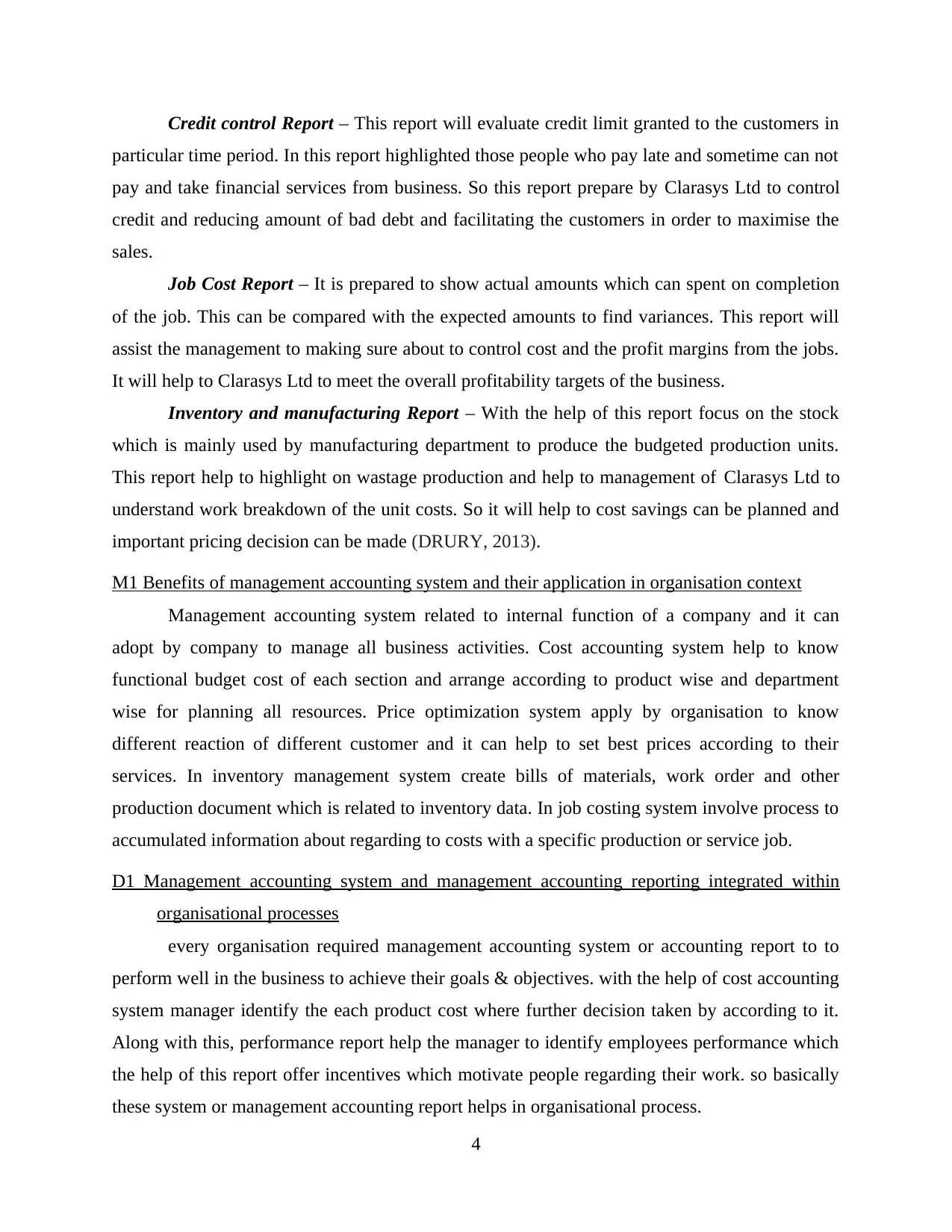
Credit control Report – This report will evaluate credit limit granted to the customers in
particular time period. In this report highlighted those people who pay late and sometime can not
pay and take financial services from business. So this report prepare by Clarasys Ltd to control
credit and reducing amount of bad debt and facilitating the customers in order to maximise the
sales.
Job Cost Report – It is prepared to show actual amounts which can spent on completion
of the job. This can be compared with the expected amounts to find variances. This report will
assist the management to making sure about to control cost and the profit margins from the jobs.
It will help to Clarasys Ltd to meet the overall profitability targets of the business.
Inventory and manufacturing Report – With the help of this report focus on the stock
which is mainly used by manufacturing department to produce the budgeted production units.
This report help to highlight on wastage production and help to management of Clarasys Ltd to
understand work breakdown of the unit costs. So it will help to cost savings can be planned and
important pricing decision can be made (DRURY, 2013).
M1 Benefits of management accounting system and their application in organisation context
Management accounting system related to internal function of a company and it can
adopt by company to manage all business activities. Cost accounting system help to know
functional budget cost of each section and arrange according to product wise and department
wise for planning all resources. Price optimization system apply by organisation to know
different reaction of different customer and it can help to set best prices according to their
services. In inventory management system create bills of materials, work order and other
production document which is related to inventory data. In job costing system involve process to
accumulated information about regarding to costs with a specific production or service job.
D1 Management accounting system and management accounting reporting integrated within
organisational processes
every organisation required management accounting system or accounting report to to
perform well in the business to achieve their goals & objectives. with the help of cost accounting
system manager identify the each product cost where further decision taken by according to it.
Along with this, performance report help the manager to identify employees performance which
the help of this report offer incentives which motivate people regarding their work. so basically
these system or management accounting report helps in organisational process.
4
particular time period. In this report highlighted those people who pay late and sometime can not
pay and take financial services from business. So this report prepare by Clarasys Ltd to control
credit and reducing amount of bad debt and facilitating the customers in order to maximise the
sales.
Job Cost Report – It is prepared to show actual amounts which can spent on completion
of the job. This can be compared with the expected amounts to find variances. This report will
assist the management to making sure about to control cost and the profit margins from the jobs.
It will help to Clarasys Ltd to meet the overall profitability targets of the business.
Inventory and manufacturing Report – With the help of this report focus on the stock
which is mainly used by manufacturing department to produce the budgeted production units.
This report help to highlight on wastage production and help to management of Clarasys Ltd to
understand work breakdown of the unit costs. So it will help to cost savings can be planned and
important pricing decision can be made (DRURY, 2013).
M1 Benefits of management accounting system and their application in organisation context
Management accounting system related to internal function of a company and it can
adopt by company to manage all business activities. Cost accounting system help to know
functional budget cost of each section and arrange according to product wise and department
wise for planning all resources. Price optimization system apply by organisation to know
different reaction of different customer and it can help to set best prices according to their
services. In inventory management system create bills of materials, work order and other
production document which is related to inventory data. In job costing system involve process to
accumulated information about regarding to costs with a specific production or service job.
D1 Management accounting system and management accounting reporting integrated within
organisational processes
every organisation required management accounting system or accounting report to to
perform well in the business to achieve their goals & objectives. with the help of cost accounting
system manager identify the each product cost where further decision taken by according to it.
Along with this, performance report help the manager to identify employees performance which
the help of this report offer incentives which motivate people regarding their work. so basically
these system or management accounting report helps in organisational process.
4
⊘ This is a preview!⊘
Do you want full access?
Subscribe today to unlock all pages.

Trusted by 1+ million students worldwide
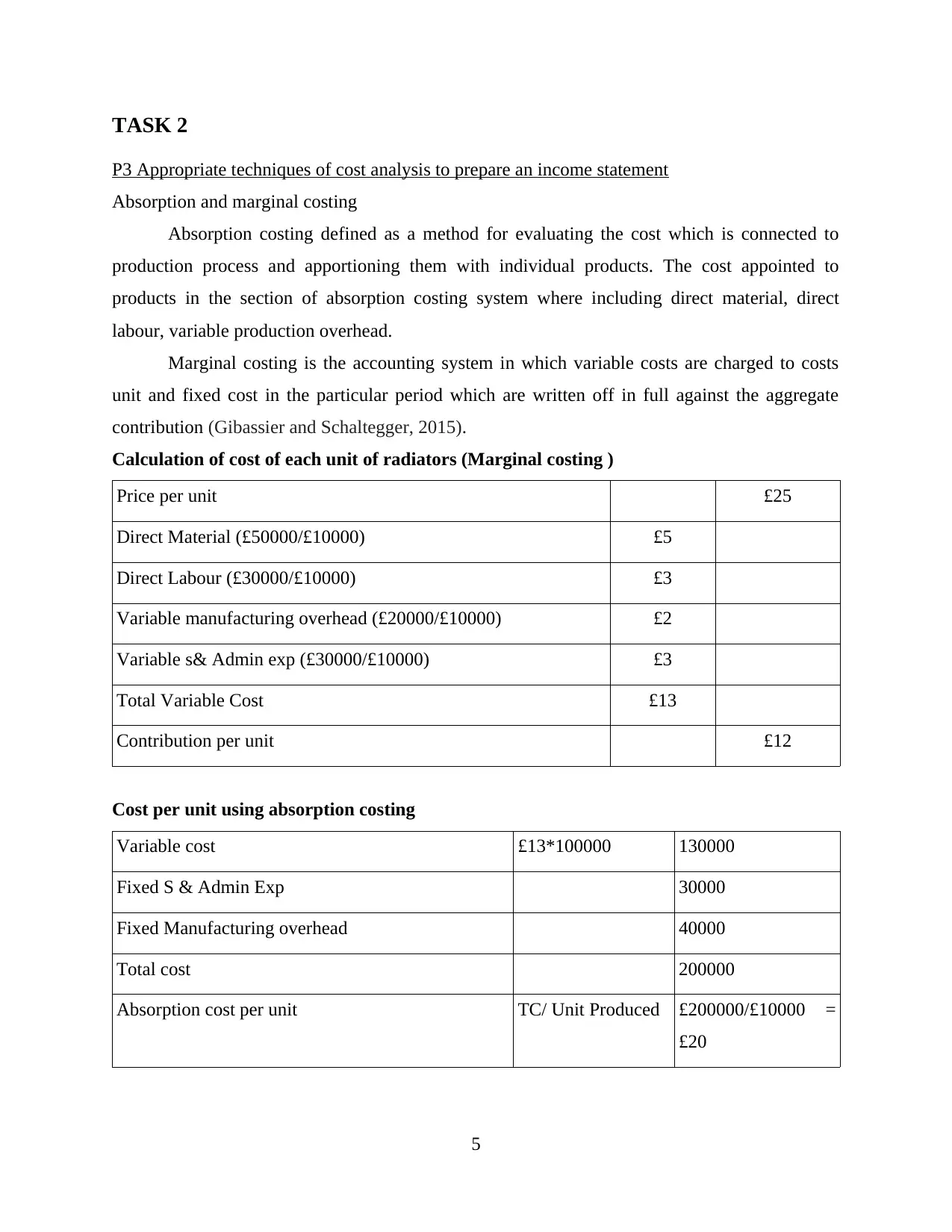
TASK 2
P3 Appropriate techniques of cost analysis to prepare an income statement
Absorption and marginal costing
Absorption costing defined as a method for evaluating the cost which is connected to
production process and apportioning them with individual products. The cost appointed to
products in the section of absorption costing system where including direct material, direct
labour, variable production overhead.
Marginal costing is the accounting system in which variable costs are charged to costs
unit and fixed cost in the particular period which are written off in full against the aggregate
contribution (Gibassier and Schaltegger, 2015).
Calculation of cost of each unit of radiators (Marginal costing )
Price per unit £25
Direct Material (£50000/£10000) £5
Direct Labour (£30000/£10000) £3
Variable manufacturing overhead (£20000/£10000) £2
Variable s& Admin exp (£30000/£10000) £3
Total Variable Cost £13
Contribution per unit £12
Cost per unit using absorption costing
Variable cost £13*100000 130000
Fixed S & Admin Exp 30000
Fixed Manufacturing overhead 40000
Total cost 200000
Absorption cost per unit TC/ Unit Produced £200000/£10000 =
£20
5
P3 Appropriate techniques of cost analysis to prepare an income statement
Absorption and marginal costing
Absorption costing defined as a method for evaluating the cost which is connected to
production process and apportioning them with individual products. The cost appointed to
products in the section of absorption costing system where including direct material, direct
labour, variable production overhead.
Marginal costing is the accounting system in which variable costs are charged to costs
unit and fixed cost in the particular period which are written off in full against the aggregate
contribution (Gibassier and Schaltegger, 2015).
Calculation of cost of each unit of radiators (Marginal costing )
Price per unit £25
Direct Material (£50000/£10000) £5
Direct Labour (£30000/£10000) £3
Variable manufacturing overhead (£20000/£10000) £2
Variable s& Admin exp (£30000/£10000) £3
Total Variable Cost £13
Contribution per unit £12
Cost per unit using absorption costing
Variable cost £13*100000 130000
Fixed S & Admin Exp 30000
Fixed Manufacturing overhead 40000
Total cost 200000
Absorption cost per unit TC/ Unit Produced £200000/£10000 =
£20
5
Paraphrase This Document
Need a fresh take? Get an instant paraphrase of this document with our AI Paraphraser
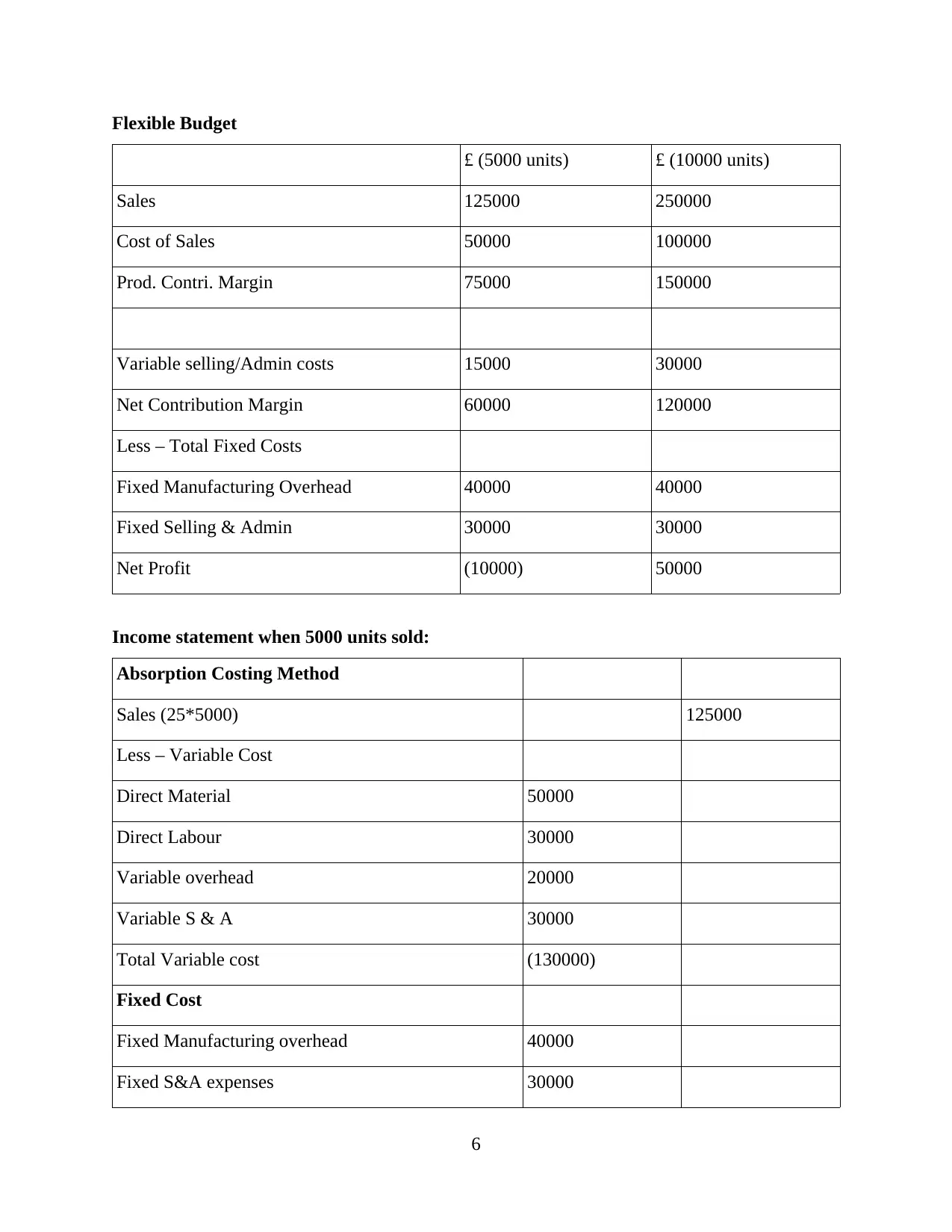
Flexible Budget
£ (5000 units) £ (10000 units)
Sales 125000 250000
Cost of Sales 50000 100000
Prod. Contri. Margin 75000 150000
Variable selling/Admin costs 15000 30000
Net Contribution Margin 60000 120000
Less – Total Fixed Costs
Fixed Manufacturing Overhead 40000 40000
Fixed Selling & Admin 30000 30000
Net Profit (10000) 50000
Income statement when 5000 units sold:
Absorption Costing Method
Sales (25*5000) 125000
Less – Variable Cost
Direct Material 50000
Direct Labour 30000
Variable overhead 20000
Variable S & A 30000
Total Variable cost (130000)
Fixed Cost
Fixed Manufacturing overhead 40000
Fixed S&A expenses 30000
6
£ (5000 units) £ (10000 units)
Sales 125000 250000
Cost of Sales 50000 100000
Prod. Contri. Margin 75000 150000
Variable selling/Admin costs 15000 30000
Net Contribution Margin 60000 120000
Less – Total Fixed Costs
Fixed Manufacturing Overhead 40000 40000
Fixed Selling & Admin 30000 30000
Net Profit (10000) 50000
Income statement when 5000 units sold:
Absorption Costing Method
Sales (25*5000) 125000
Less – Variable Cost
Direct Material 50000
Direct Labour 30000
Variable overhead 20000
Variable S & A 30000
Total Variable cost (130000)
Fixed Cost
Fixed Manufacturing overhead 40000
Fixed S&A expenses 30000
6
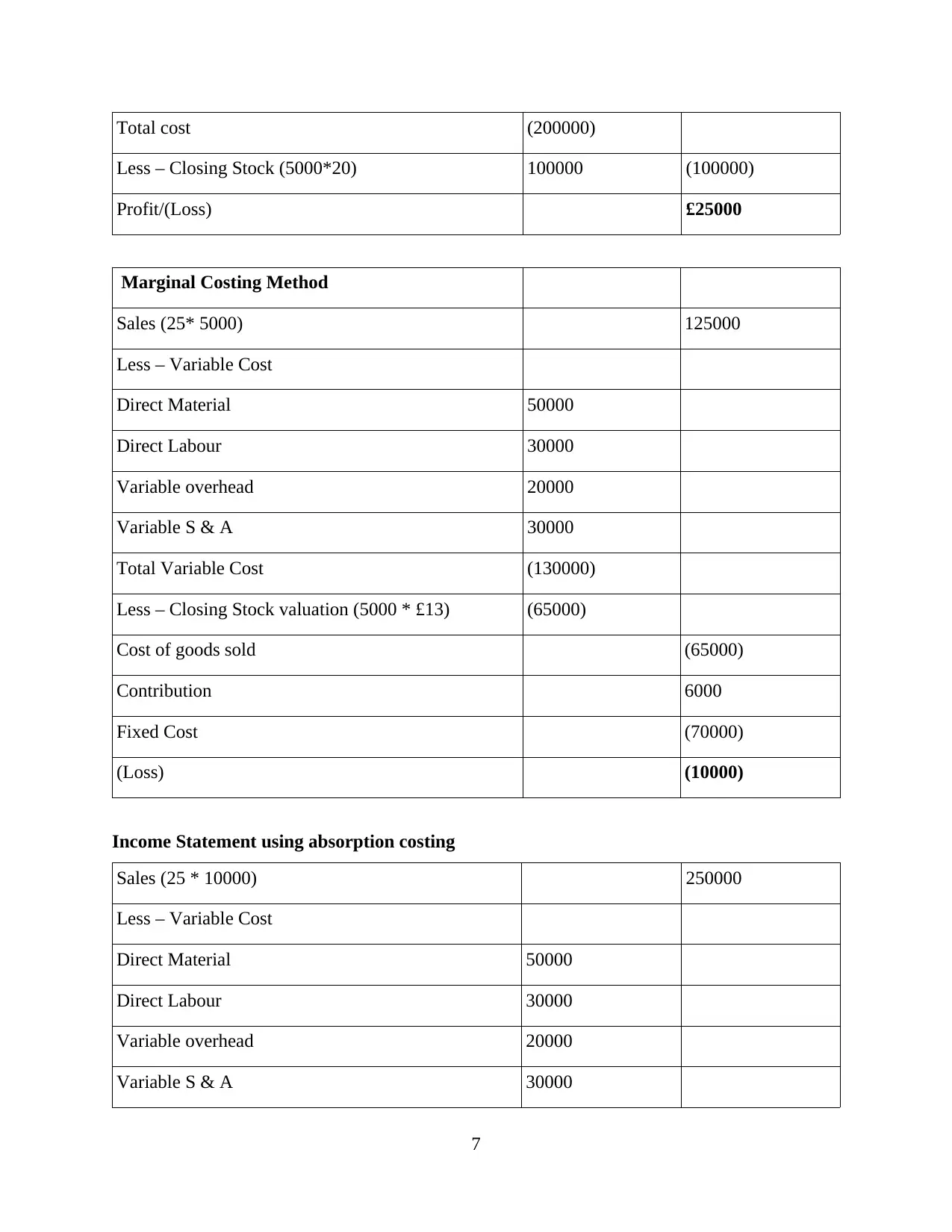
Total cost (200000)
Less – Closing Stock (5000*20) 100000 (100000)
Profit/(Loss) £25000
Marginal Costing Method
Sales (25* 5000) 125000
Less – Variable Cost
Direct Material 50000
Direct Labour 30000
Variable overhead 20000
Variable S & A 30000
Total Variable Cost (130000)
Less – Closing Stock valuation (5000 * £13) (65000)
Cost of goods sold (65000)
Contribution 6000
Fixed Cost (70000)
(Loss) (10000)
Income Statement using absorption costing
Sales (25 * 10000) 250000
Less – Variable Cost
Direct Material 50000
Direct Labour 30000
Variable overhead 20000
Variable S & A 30000
7
Less – Closing Stock (5000*20) 100000 (100000)
Profit/(Loss) £25000
Marginal Costing Method
Sales (25* 5000) 125000
Less – Variable Cost
Direct Material 50000
Direct Labour 30000
Variable overhead 20000
Variable S & A 30000
Total Variable Cost (130000)
Less – Closing Stock valuation (5000 * £13) (65000)
Cost of goods sold (65000)
Contribution 6000
Fixed Cost (70000)
(Loss) (10000)
Income Statement using absorption costing
Sales (25 * 10000) 250000
Less – Variable Cost
Direct Material 50000
Direct Labour 30000
Variable overhead 20000
Variable S & A 30000
7
⊘ This is a preview!⊘
Do you want full access?
Subscribe today to unlock all pages.

Trusted by 1+ million students worldwide
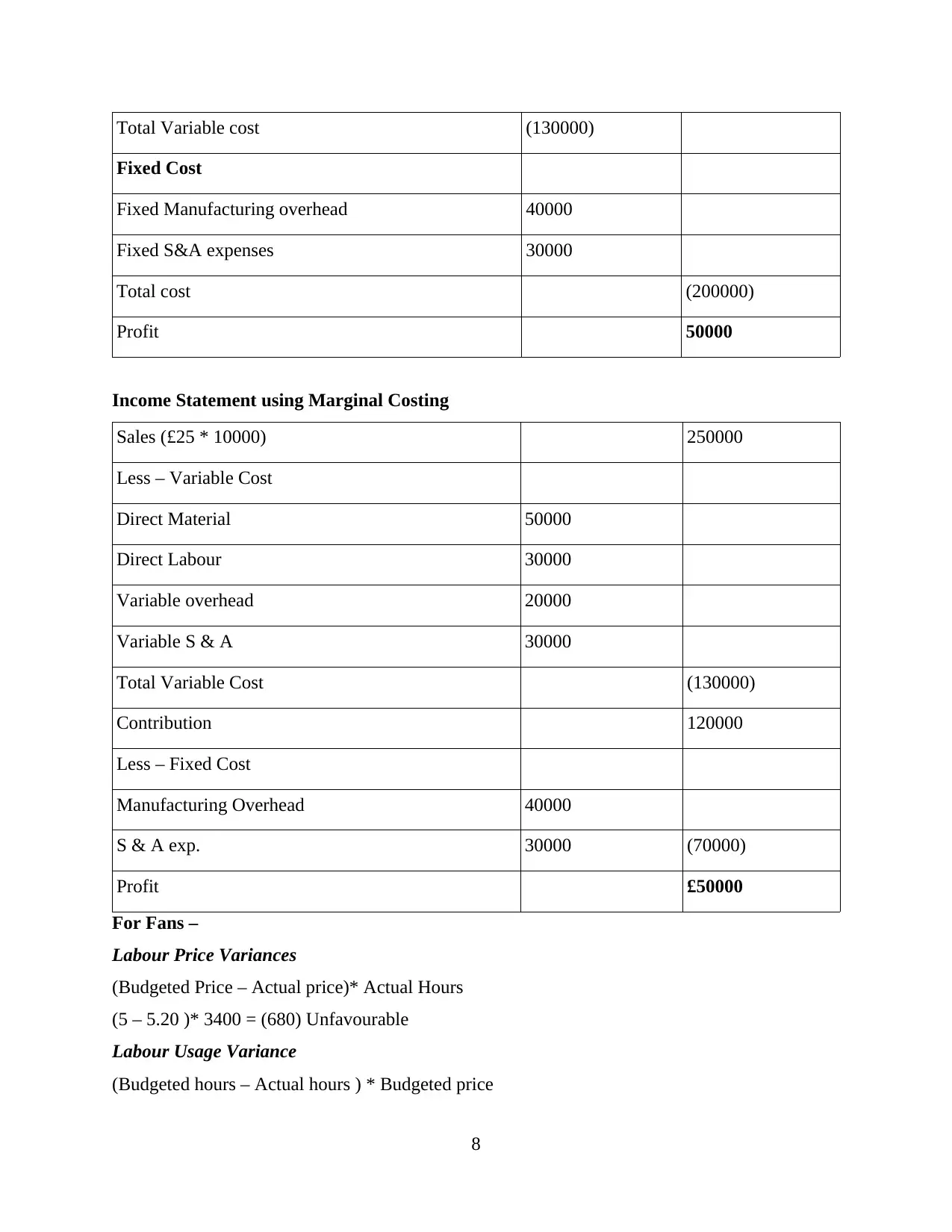
Total Variable cost (130000)
Fixed Cost
Fixed Manufacturing overhead 40000
Fixed S&A expenses 30000
Total cost (200000)
Profit 50000
Income Statement using Marginal Costing
Sales (£25 * 10000) 250000
Less – Variable Cost
Direct Material 50000
Direct Labour 30000
Variable overhead 20000
Variable S & A 30000
Total Variable Cost (130000)
Contribution 120000
Less – Fixed Cost
Manufacturing Overhead 40000
S & A exp. 30000 (70000)
Profit £50000
For Fans –
Labour Price Variances
(Budgeted Price – Actual price)* Actual Hours
(5 – 5.20 )* 3400 = (680) Unfavourable
Labour Usage Variance
(Budgeted hours – Actual hours ) * Budgeted price
8
Fixed Cost
Fixed Manufacturing overhead 40000
Fixed S&A expenses 30000
Total cost (200000)
Profit 50000
Income Statement using Marginal Costing
Sales (£25 * 10000) 250000
Less – Variable Cost
Direct Material 50000
Direct Labour 30000
Variable overhead 20000
Variable S & A 30000
Total Variable Cost (130000)
Contribution 120000
Less – Fixed Cost
Manufacturing Overhead 40000
S & A exp. 30000 (70000)
Profit £50000
For Fans –
Labour Price Variances
(Budgeted Price – Actual price)* Actual Hours
(5 – 5.20 )* 3400 = (680) Unfavourable
Labour Usage Variance
(Budgeted hours – Actual hours ) * Budgeted price
8
Paraphrase This Document
Need a fresh take? Get an instant paraphrase of this document with our AI Paraphraser
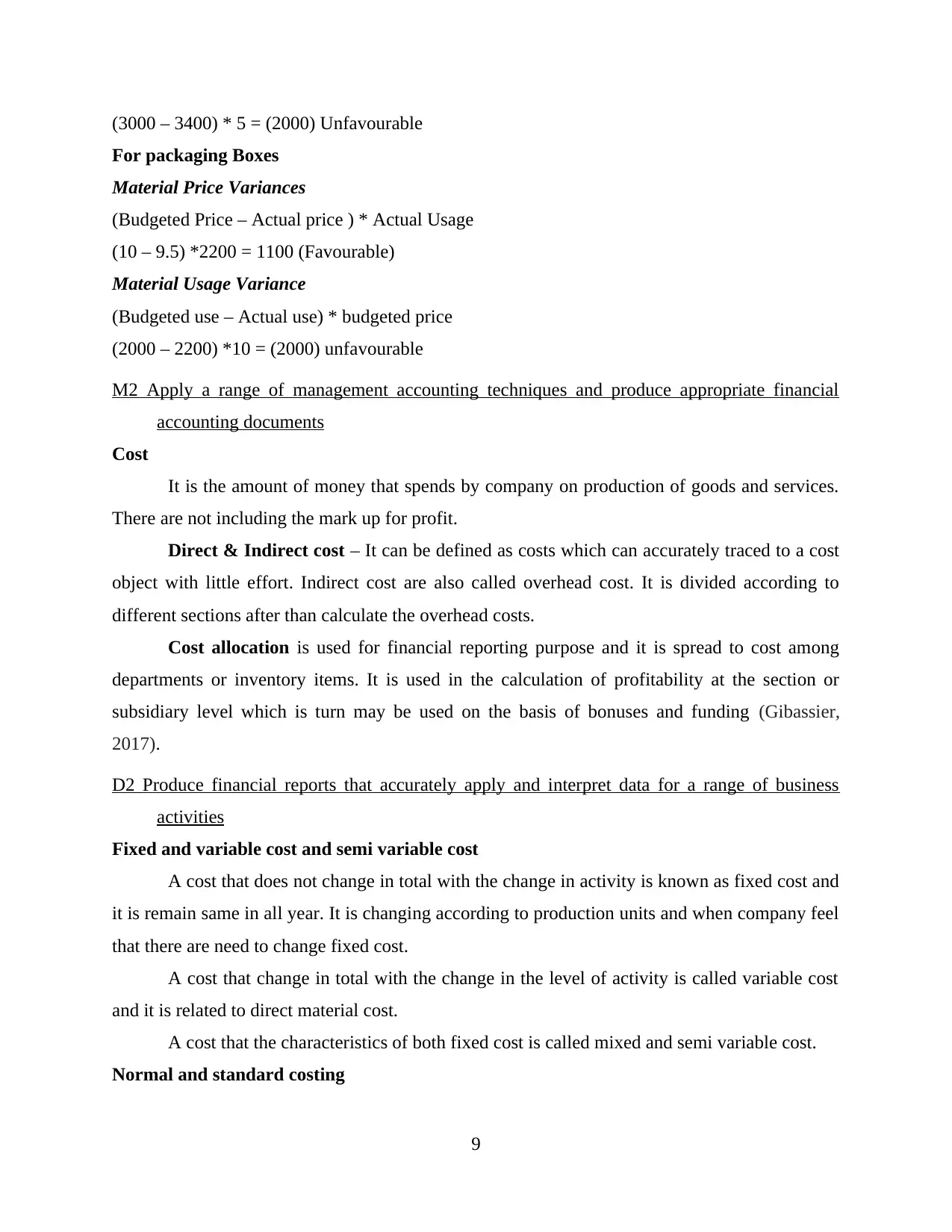
(3000 – 3400) * 5 = (2000) Unfavourable
For packaging Boxes
Material Price Variances
(Budgeted Price – Actual price ) * Actual Usage
(10 – 9.5) *2200 = 1100 (Favourable)
Material Usage Variance
(Budgeted use – Actual use) * budgeted price
(2000 – 2200) *10 = (2000) unfavourable
M2 Apply a range of management accounting techniques and produce appropriate financial
accounting documents
Cost
It is the amount of money that spends by company on production of goods and services.
There are not including the mark up for profit.
Direct & Indirect cost – It can be defined as costs which can accurately traced to a cost
object with little effort. Indirect cost are also called overhead cost. It is divided according to
different sections after than calculate the overhead costs.
Cost allocation is used for financial reporting purpose and it is spread to cost among
departments or inventory items. It is used in the calculation of profitability at the section or
subsidiary level which is turn may be used on the basis of bonuses and funding (Gibassier,
2017).
D2 Produce financial reports that accurately apply and interpret data for a range of business
activities
Fixed and variable cost and semi variable cost
A cost that does not change in total with the change in activity is known as fixed cost and
it is remain same in all year. It is changing according to production units and when company feel
that there are need to change fixed cost.
A cost that change in total with the change in the level of activity is called variable cost
and it is related to direct material cost.
A cost that the characteristics of both fixed cost is called mixed and semi variable cost.
Normal and standard costing
9
For packaging Boxes
Material Price Variances
(Budgeted Price – Actual price ) * Actual Usage
(10 – 9.5) *2200 = 1100 (Favourable)
Material Usage Variance
(Budgeted use – Actual use) * budgeted price
(2000 – 2200) *10 = (2000) unfavourable
M2 Apply a range of management accounting techniques and produce appropriate financial
accounting documents
Cost
It is the amount of money that spends by company on production of goods and services.
There are not including the mark up for profit.
Direct & Indirect cost – It can be defined as costs which can accurately traced to a cost
object with little effort. Indirect cost are also called overhead cost. It is divided according to
different sections after than calculate the overhead costs.
Cost allocation is used for financial reporting purpose and it is spread to cost among
departments or inventory items. It is used in the calculation of profitability at the section or
subsidiary level which is turn may be used on the basis of bonuses and funding (Gibassier,
2017).
D2 Produce financial reports that accurately apply and interpret data for a range of business
activities
Fixed and variable cost and semi variable cost
A cost that does not change in total with the change in activity is known as fixed cost and
it is remain same in all year. It is changing according to production units and when company feel
that there are need to change fixed cost.
A cost that change in total with the change in the level of activity is called variable cost
and it is related to direct material cost.
A cost that the characteristics of both fixed cost is called mixed and semi variable cost.
Normal and standard costing
9
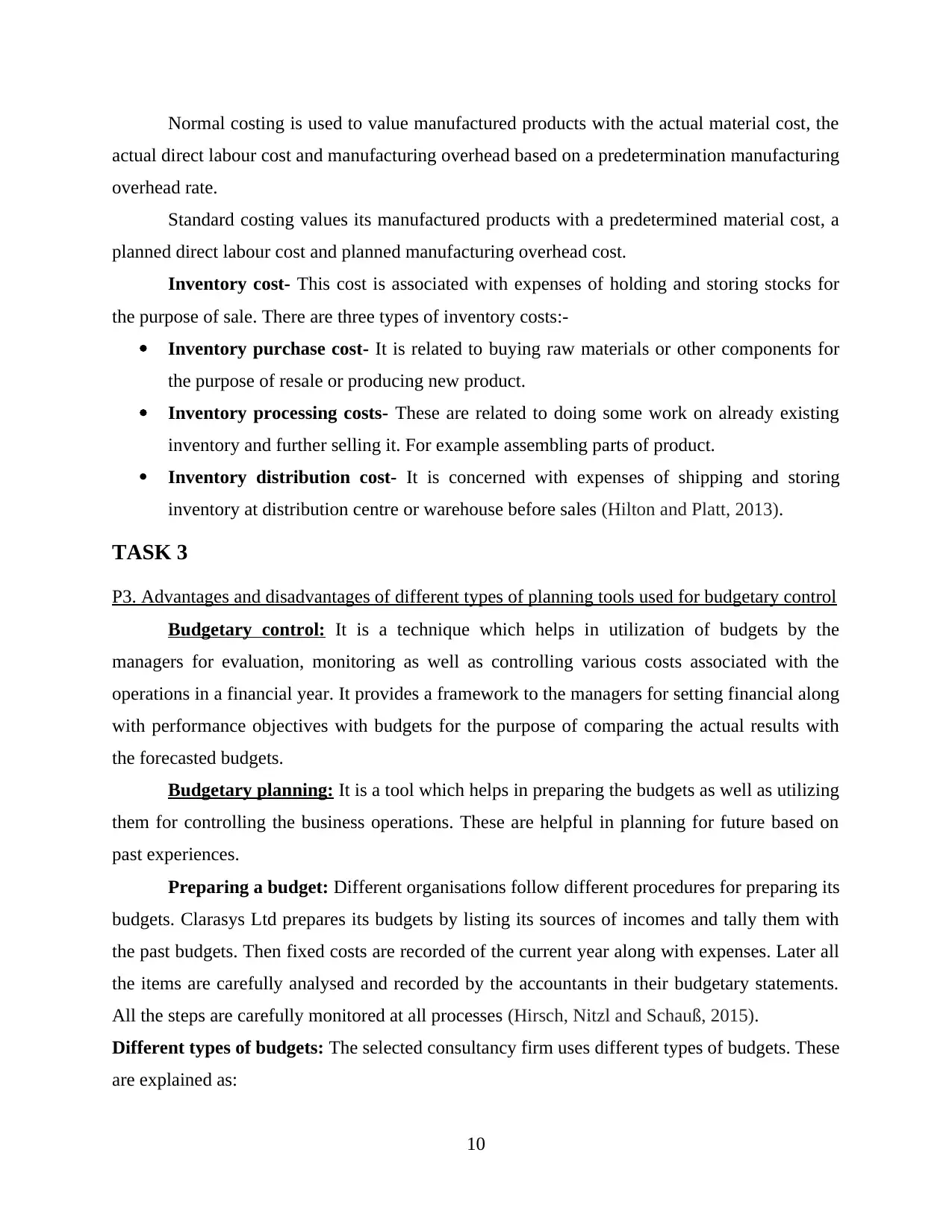
Normal costing is used to value manufactured products with the actual material cost, the
actual direct labour cost and manufacturing overhead based on a predetermination manufacturing
overhead rate.
Standard costing values its manufactured products with a predetermined material cost, a
planned direct labour cost and planned manufacturing overhead cost.
Inventory cost- This cost is associated with expenses of holding and storing stocks for
the purpose of sale. There are three types of inventory costs:-
Inventory purchase cost- It is related to buying raw materials or other components for
the purpose of resale or producing new product.
Inventory processing costs- These are related to doing some work on already existing
inventory and further selling it. For example assembling parts of product.
Inventory distribution cost- It is concerned with expenses of shipping and storing
inventory at distribution centre or warehouse before sales (Hilton and Platt, 2013).
TASK 3
P3. Advantages and disadvantages of different types of planning tools used for budgetary control
Budgetary control: It is a technique which helps in utilization of budgets by the
managers for evaluation, monitoring as well as controlling various costs associated with the
operations in a financial year. It provides a framework to the managers for setting financial along
with performance objectives with budgets for the purpose of comparing the actual results with
the forecasted budgets.
Budgetary planning: It is a tool which helps in preparing the budgets as well as utilizing
them for controlling the business operations. These are helpful in planning for future based on
past experiences.
Preparing a budget: Different organisations follow different procedures for preparing its
budgets. Clarasys Ltd prepares its budgets by listing its sources of incomes and tally them with
the past budgets. Then fixed costs are recorded of the current year along with expenses. Later all
the items are carefully analysed and recorded by the accountants in their budgetary statements.
All the steps are carefully monitored at all processes (Hirsch, Nitzl and Schauß, 2015).
Different types of budgets: The selected consultancy firm uses different types of budgets. These
are explained as:
10
actual direct labour cost and manufacturing overhead based on a predetermination manufacturing
overhead rate.
Standard costing values its manufactured products with a predetermined material cost, a
planned direct labour cost and planned manufacturing overhead cost.
Inventory cost- This cost is associated with expenses of holding and storing stocks for
the purpose of sale. There are three types of inventory costs:-
Inventory purchase cost- It is related to buying raw materials or other components for
the purpose of resale or producing new product.
Inventory processing costs- These are related to doing some work on already existing
inventory and further selling it. For example assembling parts of product.
Inventory distribution cost- It is concerned with expenses of shipping and storing
inventory at distribution centre or warehouse before sales (Hilton and Platt, 2013).
TASK 3
P3. Advantages and disadvantages of different types of planning tools used for budgetary control
Budgetary control: It is a technique which helps in utilization of budgets by the
managers for evaluation, monitoring as well as controlling various costs associated with the
operations in a financial year. It provides a framework to the managers for setting financial along
with performance objectives with budgets for the purpose of comparing the actual results with
the forecasted budgets.
Budgetary planning: It is a tool which helps in preparing the budgets as well as utilizing
them for controlling the business operations. These are helpful in planning for future based on
past experiences.
Preparing a budget: Different organisations follow different procedures for preparing its
budgets. Clarasys Ltd prepares its budgets by listing its sources of incomes and tally them with
the past budgets. Then fixed costs are recorded of the current year along with expenses. Later all
the items are carefully analysed and recorded by the accountants in their budgetary statements.
All the steps are carefully monitored at all processes (Hirsch, Nitzl and Schauß, 2015).
Different types of budgets: The selected consultancy firm uses different types of budgets. These
are explained as:
10
⊘ This is a preview!⊘
Do you want full access?
Subscribe today to unlock all pages.

Trusted by 1+ million students worldwide
1 out of 20
Related Documents
Your All-in-One AI-Powered Toolkit for Academic Success.
+13062052269
info@desklib.com
Available 24*7 on WhatsApp / Email
![[object Object]](/_next/static/media/star-bottom.7253800d.svg)
Unlock your academic potential
Copyright © 2020–2025 A2Z Services. All Rights Reserved. Developed and managed by ZUCOL.





